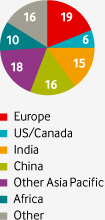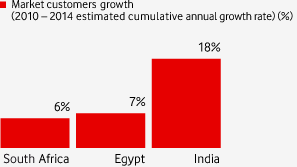
A growing industry
Data traffic has more than doubled year-on-year due to usage of smart connected devices and significant progress in mobile network technology.
Mobile telecommunications industry
An industry with 5.6 billion customers with growth driven by increasing global demand for data services and rising mobile penetration in emerging markets
Where the industry is now
Revenue and customers
- The mobile industry generates around US$900 billion of annual revenue and accounts for around 1.5% of world GDP.
- There are 5.6 billion mobile customers which is equivalent to around 80% of the world population.
- Approximately 75% of mobile customers are in emerging markets such as India and China.
Mobile services account for around 60% of telecommunications revenue with the remainder coming from fixed. Within mobile the majority of income comes from voice calls in mature markets such as Europe. However, the fastest growing revenue segment is data services such as access to the internet through laptops, tablets and smartphones.
The number of mobile customers far exceeds other forms of electronic communication. Only 1.3 billion people have fixed line telephones, 2.1 billion have access to the internet and 1.2 billion have televisions.
The mobile proportion of voice calls has increased over the last five years and now accounts for 82% of all calls made, with the remainder over fixed lines, reflecting the benefits of mobility, lower cost handsets and cheaper calling plans.
Mobile customers
March 2011: 5.6 billion
(%)

Competition and regulation
- There are typically between three to five mobile network operators per market, although in some markets, such as India, there are considerably more.
- Regulators continue to seek to impose policies to lower the cost of access to mobile networks.
The telecommunications industry is competitive with consumers having a large choice of mobile and fixed line operators from which to select services. Newer competitors, including handset manufacturers, internet companies and software providers, are also entering the market offering integrated communication services.
Industry regulators continue to impose lower mobile termination rates (the fees mobile companies charge for calls received from other companies’ networks) and lower roaming prices.
The combination of competition and regulatory pressures contributed to a 10% decline in the global average price per minute in the 2010 calendar year. However, price pressures are being partly offset by increased mobile usage leading to a 6% increase in mobile service revenue over the same period.
Mobile penetration
March 2011 (%)

Where the industry is going
Mobile data and networks
- Mobile data traffic is driving revenue growth.
- Network speeds are increasing dramatically because of improving technology.
- The pace of product innovation remains high.
In 2006 data accounted for 3% of industry revenue, in 2010 it reached 13% and by 2014 it is expected to be 21%. Demand is being driven by the widening range of smart connected devices, such as mobile broadband sticks, smartphones and tablets, greater network speeds and an increased range of applications with greater functionality. Smartphone sales grew by 66% in the 2010 calendar year, compared to a 16% increase in the 2009 calendar year, and are expected to continue to grow due to lower entry prices, device innovation and attractive applications.
Today’s 3G networks offer typically achieved data download speeds of up to 4 Mbps which is around 100 times faster than that delivered by 2G networks ten years ago. The industry has recently begun to deploy 4G/LTE networks which will provide typically achieved rates of up to 12 Mbps, depending on the capability of the devices and the network.
Device innovation is a key feature of our industry. Recent developments include femtocells which enhance customers’ indoor 3G signals via a fixed line broadband connection and mobile Wi-Fi devices which allow customers to share their mobile broadband connection with others.
Mobile data demand is being accelerated by devices and network improvements
| 2006 | 2010 | |
|---|---|---|
| Smartphone share of industry handset shipments (%) | 8 | 21 |
| Typically achieved data download speeds (Mbps) | 2.2 | 4 |
Emerging markets
- Mobile phone usage continues to grow rapidly.
- Data represents a significant growth opportunity.
The number of customers using mobile services in emerging markets such as India and Africa has grown rapidly over the last ten years, increasing by over 17 times, compared to nearly 130% in more mature markets such as Europe. The key driver of growth has been a fundamental need for communication services against a background of often low quality alternative fixed line infrastructure and strong economic growth.
Most of the future growth in mobile customers is expected to continue to be in emerging markets where mobile penetration is only around 70% compared to approximately 130% in mature markets such as Europe, supported by the expectation of continued strong economic growth.
Data also represents a substantial growth opportunity in emerging markets both in terms of mobile broadband and mobile internet services. It is being driven partly by the lack of fixed line broadband infrastructure but also by locally relevant content and services in local languages, and software innovations that give customers a high-quality mobile internet experience on affordable handsets.
Emerging market customer growth will be driven by rising mobile penetration and GDP growth

The industry data on this page has been sourced from Wireless Intelligence, Strategy Analytics, Merrill Lynch, Informa WCIS and CISCO.
